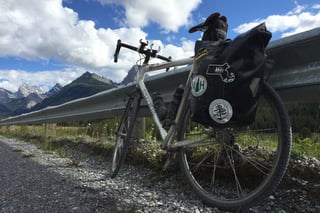I’m bleeding down my leg, and my bike shorts are ripped, while I can barely hold onto my handlebars due to the road rash on my palms. My back wheel, untrue because of all the weight (50+ pounds) I have tied on top of it, is rubbing against the brake pads, slowing me down and making a sound like a rusty screen door. At an altitude of over seven thousand feet with a sunburnt neck, I have zero cell phone reception and am trying to stick close to the roadside shoulder as cars and RVs zip by me inches away.
When most people think of vacations, they imagine a beach, book, and sunscreen, or possibly an all-inclusive resort with mini-umbrellas in drinks. I get it. That’s the point of vacation: to relax in a different setting. However, to me, the relaxation portion of vacation cannot be truly appreciated without first challenging myself with something outside my comfort zone. That is why every summer, I take a bike touring trip for a few weeks. I’ve ridden across Greece, up and down the Rhine in Germany, through New England, and then just this summer, 1400 miles down through the Rocky Mountains of North America.

Bike touring obviously gives me time to reflect on the past school year and contemplate ideas for the upcoming year. But it also gives me a basis from which to rely upon when pushing students to the limits of their own abilities. It would be easy for me to do so if I never challenged myself, but by voluntarily putting myself through a difficult task every summer in which I have to calculate risk every step of the way, I have the ability to empathize with the students who do so every day in my class.
I ask a lot of my eighth-grade students. They grapple with the complex writing of Faulkner, Capote, and Shakespeare while pushing themselves to write with organization, style, and fluidity. To get to the point of understanding and demonstrating those skills, they need to be able to take risks… and fail. Nevertheless, they also need to have the mindfulness to be self-aware of the journey that led to that failure and then to learn from it.
Alongside our study of Shakespeare’s Romeo and Juliet, two risk-prone teenagers, we read and learn about the benefits of risk-taking in adolescent development:
- England’s Fair Play initiative builds off of the idea that “children need to take risks to learn how to manage risks… an essential part of growing up.”
- In the book Tomorrow’s Change Makers: Reclaiming the Power of Citizenship for a New Generation, the author, Marilyn Price-Mitchell Ph.D., argues that adolescents discover their identities through risk-taking, which many see as a source of happiness.
- In Sarah-Jayne Blakemore’s TED Talk on the adolescent brain, she argues that instead of stigmatizing teenage risk-taking, we should accept it as a reflection of natural brain development that leads to opportunities “for education and social development.”
Last June, I implored my eighth-graders to continue to take risks, praising them for the ones they have already taken the past few years, and imploring them to keep it up. I personally do not regret the risks I have taken, I only regret the risks I have not taken because the resulting growth and learning are impossible to measure. The same goes for my teaching in the classroom. Not every risk works, but as long as I’m honest with myself and, more importantly, transparent with my students, no moment goes wasted.
Max Schneider is the eighth-grade English teacher, coach, and advisor at Sanford School, a PreK-Grade 12 College Preparatory School in Hockessin Delaware.








